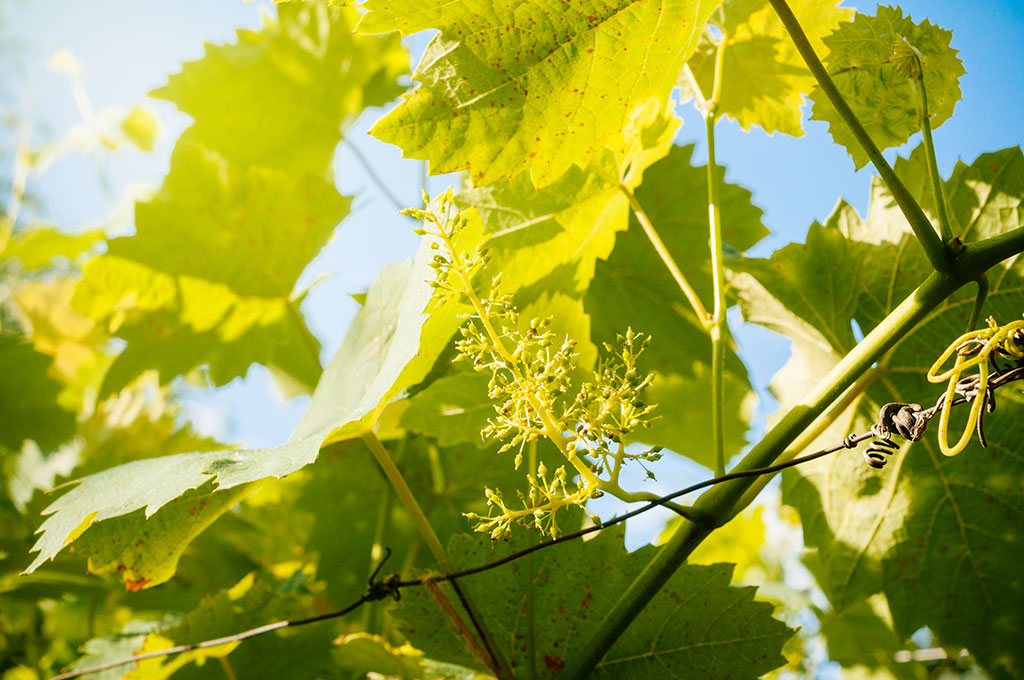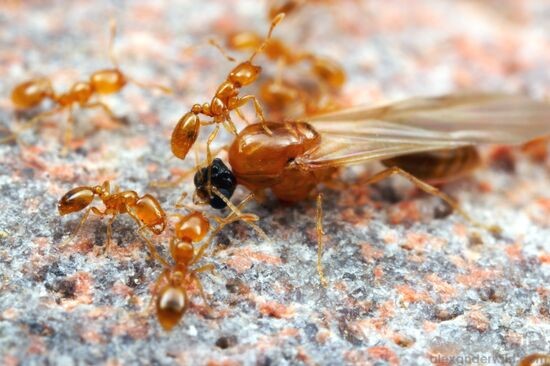According to an Australian study by CSIRO, reduced precipitations during winter delay budburst and decrease subsequent yield by up to 40%. Excessively dry soil conditions can also cause growth disorders. For example, in central California, the 2021 winter drought had severe consequences on vineyards . Many growers reported delayed phenology, poor growth, and fruit abortion. Some severely impacted vineyards suffered a substantial yield loss.
The problem is known as « delayed spring growth » and can be caused by lack of soil moisture. It results in bud wilting, stunted growth and, in severe cases, fruit shatter and abortion. It is partly due to vascular impairment due to dry conditions. Dormant buds become dehydrated over winter and have relatively weak vascular connections to the rest of the vine. Spring sap flow (bleeding) helps repair any vascular embolisms that may have formed over the winter and rehydrates the buds. However, when the soil is excessively dry or the carbohydrate reserve too low, this process can be impaired and shoots with faulty connections do not receive adequate carbohydrate supplies at growth resumption, even if soil moisture is subsequently re-established.

Another consequence of soil dryness in winter and spring is the inhibition of fine root formation. Fine roots are non-woody, short-lived roots with very small diameters < 1 mm. They are important for resource acquisition and microbial interactions. Their growth is promoted by carbohydrate demand from the plant (in the spring, for example) and is strongly limited by the lack of soil moisture. For this reason, early season drought can lead to decreased nutrient absorbtion and cause nutrient deficiencies.
These consequences are not homogeneous in vineyards. Only some shoots are affected by unresolved vascular embolisms and dry patches in soils are often distributed hetereogeneously depending on soil variability. This results in desynchronised budburst and phenology within the same vineyard, which makes viticultural operations more complicated.
Climate change, ants and winter drought: a terrible mix for your irrigation system
In addition to its adverse effects on plant growth, winter drought can be accounted for yet another problem in vineyards: the breaking and failure of subsurface drip irrigation systems.
In recent years many vineyards in southern France have reported damage and failure of irrigation systems at the onset of the growing season. This occurred only for subsurface drip systems and after drier and warmer than average winters such as 2019. Close investigations have revelead that water emitters along the dripperline are damaged by soil-dwelling ants that search for water at the end of winter rest. When the ants cannot find water in the soil profile, they enter the irrigation system and pierce the emitter membranes to enter in the water pipes. The phenomenon has been particularly pronounced in recent years and fueled by climate change.
In most mediterranean and temperate species, ants stop foraging for food and become inactive in winter. Because their activities are greatly reduced, they can survive with their energy reserves for a few months. This slower metabolic state is called « diapause ». The increase in temperature during the early spring months cues ants to re-emerge from their chambers, prompting workers to search for new food sources and water. In the last few years, record winter temperatures have promoted earlier ant activity, inside dry soils that had not yet been irrigated. The lack of moisture has pushed ants into irrigation systems where the damages have been done.
Many different ant species live in mediterranean soils, but only a few are small enough to enter the emitters and wander through the system. In southern France, the culprits have been identified as belonging to the genus « Solenopsis ».

How to protect your vineyard: the importance of winter irrigation
Given the adverse effects that excessive soil dryness can have in winter, it is important to ensure that soils retain their moisture during winter rest and are ready to support a healthy growth resumption at the time of budburst.
In winter months, growers should assess soil moisture, review the weather forecast, and consider whether winter irrigation may be needed. If the soil is dry and no significant precipitation is in the forecast, then irrigation is recommended. Grapevines use little water over the dormant season, and lower temperatures decrease soil evaporation, so often only one irrigation will be needed in January or February.
Irrigation experts advise to perform one « technical irrigation » to fill up the soil profile to manage any potential potential growth disorders and prevent ants from damaging subsurface drip irrigation systems. To know exactly how much and how long to irrigate, a precise knowledge of soil composition and depth and the evaluation of its water holding capacity are very useful. These information can be provided by agronomic models and irrigation DSS like Vintel.
With drought setting in southern France and no significant precipitation forecasted for the next weeks it is the right time to think about “watering ” your vineyard. A strategic irrigation now can avoid many later problems and ensure a good start of the 2022 season.
Climate is changing at a rapid pace disrupting many human activities. These changes are expected to continue and have important consequences on agriculture, due to the strong link between climate variables and crop growth.
Some agroecosystems are recognized as more vulnerable because of their their climate sensitivity and their limited resilience to change.
The climate vulnerability of viticulture
Viticultural agroecosystems are included in this category for different reasons. Among them are their occurrence in geographical areas that are already water limited and will suffer from increasingly severe droughts in the next decades, the crucial effects of climate on yield and quality, and, for some regions, a structural rigidity in the wine sector preventing swift adaptation.
Grapevines are grown in climate change hotspots
Mediterranean climates are particularly well suited to viticulture, allowing a wide range of of varieties and wine styles. The long, sunny growing season gives vines an early start and allows late harvests. It also ensures a well balanced ripening process, excellent color, soft tannins and aroma. For this reason, some of the most renowned wine regions are located around the Mediterranean, in California and South Australia.
Unfortunately the Mediterranean basin has also been pointed out as a climate change hotspot, warming 20% faster than global average and with a projected decrease in precipitation of 30% by 2080. Similarly, California has experienced some of its worst droughts in the last years as a result of climate change. 2000 to 2021 have indeed been the state’s driest 22-year period over the last 1,000 years, something which has been described a an ”emerging megadrought era” by climate experts.
These alterations are already impacting the wine sector and will likely result in a disruption of traditional viticultural agroecosystems in the next decades.
Grape production depends on temperature and water availability
Viticultural systems, even more than other crop systems, are characterized by particularly strong ties between climate and production in terms of quality and quantity. Indeed, climate has a greater impact on vine development and fruit composition than soil and grapevine variety . Many individual atmospheric factors (e.g., solar radiation, wind, humidity, etc.) influence the growth and productivity of grapevines, but temperature and water availability are probably the most important. These climate variables are also those expected to change the most in the next decades, as projected by climate change scenarios.
In addition to affecting grape physiology, temperature and humidity affect also disease occurrence which is an indirect driver of yield and quality. Pests and diseases are strongly promoted/inhibited by weather variables, and climate change will probably alter the distribution of disease hotspots. For example a warmer and drier weather might result in a decrease in cool climate diseases such as downy mildew and an increase warmer climate diseases or insect pests in some regions. These changes imply that phytosanitary practices might need to be adapted to offer adequate protection to vines in the future.
Traditional wine regions are not adapting fast enough
In regions traditionally producing high-value wine such as Bordeaux in France or the Barolo region in Italy, regulations are put in place as a guarantee for the consumer. Producers may use only grapes that are permitted by the appellation authorities and the grapes may come only from certain areas. This system, thought to protect producers and consumers may reveal its fragility in times of rapid climate change. Indeed, the optimal climate for varieties and wine types is shifting quickly, meaning that new varieties and methods cannot be introduced easily without losing their prestigious labelling. Such restrictions do not exist in new world wine regions, where it is largely up to individual producers to decide what they grow and how they make their wines, making it easy to take adaptation measures.
Do you want to try a complete decision-making tool?
Climate change adaptations : towards a climate resilient viticulture
With so much at stake, it is no wonder that vine growers, wine makers and researchers have been experimenting to find adaptation measures to climate change. Some are :
Growers are considering a change in traditional varieties
Some grapevine varieties are better suited to warm climates than others. They generally have a later phenology, they are more tolerant to drought and high temperatures and they are more resistant to disease and produce less sugar with higher acidity. New varieties can also be created by specifically selecting climate-resilient traits, helped by genetics and ecophysiology. These varieties can be planted in areas that have cool climate varieties and are suffering because of climate change. This is already happening in Bordeaux and Napa Valley, two prestigious regions closely associated with cabernet sauvignon. In Bordeaux, where producers may use only grapes that are permitted by the appellation authorities and they can substitute traditional varieties only up to a small percentage. In new world countries such as California, grape growers are more free to adapt their production to the changing climate.
Practices are adapting to buffer climatic changes
Viticultural practices can be adapted to maximize available moisture and minimize heat in the vineyard. For example, decreasing the density of plots reduces hydric stress and choosing trellis systems resulting in more horizontal canopies can shield grapes from sun and excessive heat. Soil practices also matter, in particular those increasing organic matter that maximize water retention near the roots.

Finally, irrigation is key to protect yield and quality. However, as water is becoming a precious resource in dry areas, the focus is on more and more precise irrigation strategies, providing vines with the right amount of water in the moment when it is most needed.
Vineyards are moving to cooler areas and regions
As a result of warming, areas that were previously considered too cold are now becoming suitable for commercial viticulture. Vineyards are now planted at higher altitudes, or in cool regions that are not classically considered suitable for wine making, but are becoming so as a result of warming. For example, many viticultural domains have been planted in recent years in the south of the UK , where the surface of grape-growing land is increasing by 1000 ha each year. Another adaptation has been the planting of vineyards on north facing slopes in warm regions. Northern exposure decreases solar radiation and temperature counteracting the negative effects of warming on vines.
A smarter viticulture
It is now clear that the key to ensuring viticultural sustainability in the face of climate change will reside in the flexibility and willingness to change traditional habits to embrace new, climate-smart habits and technologies. To increase viticultural resilience and preserve yield and quality, it is crucial to optimize viticultural practices to match the changing climate and increase their precision.
Smart technology come to the aid of growers to anticipate the effects of these changes and put in place resilient practices ans tools to protect production.
One of them is Vintel : an all-in-one solution to manage vineyards. Vintel is an application for computer and smartphone, based on agronomic models that simulate, day by day, the water, nutrient and disease status of your vineyard and help you take the best decisions in the face of climate change.
Contact us now and ask for a demo!


